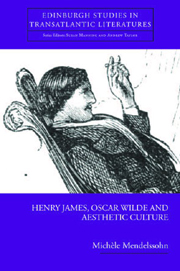Book contents
- Frontmatter
- Contents
- Acknowledgements
- List of Abbreviations
- List of Figures
- Dedication
- Introduction
- 1 ‘I Have Asked Henry James Not to Bring his Friend Oscar Wilde’: Daisy Miller, Washington Square and The Politics of Transatlantic Aestheticism
- 2 The Gentle Art of Making Enemies and of Remaking Aestheticism
- 3 The School of the Future as well as the Present: Wilde's Impressions of James in Intentions and The Picture of Dorian Gray
- 4 ‘Wild Thoughts and Desire! Things I Can't Tell You – Words I Can't Speak!’: The Drama of Identity in The Importance of Being Earnest and Guy Domville
- 5 Despoiling Poynton: James, the Wilde Trials and Interior Decoration
- 6 ‘A Nest of Almost Infant Blackmailers’: The End of Innocence in The Turn of the Screw and De Profundis
- Bibliography
- Index
Introduction
Published online by Cambridge University Press: 12 September 2012
- Frontmatter
- Contents
- Acknowledgements
- List of Abbreviations
- List of Figures
- Dedication
- Introduction
- 1 ‘I Have Asked Henry James Not to Bring his Friend Oscar Wilde’: Daisy Miller, Washington Square and The Politics of Transatlantic Aestheticism
- 2 The Gentle Art of Making Enemies and of Remaking Aestheticism
- 3 The School of the Future as well as the Present: Wilde's Impressions of James in Intentions and The Picture of Dorian Gray
- 4 ‘Wild Thoughts and Desire! Things I Can't Tell You – Words I Can't Speak!’: The Drama of Identity in The Importance of Being Earnest and Guy Domville
- 5 Despoiling Poynton: James, the Wilde Trials and Interior Decoration
- 6 ‘A Nest of Almost Infant Blackmailers’: The End of Innocence in The Turn of the Screw and De Profundis
- Bibliography
- Index
Summary
What did it mean ‘to be truly aesthetic’? In 1882, J. N. Piercy's of Binghamton, NY would have had us believe that ‘being aesthetic’ meant buying ice cream and confections at their store (Figure Intro.1, overleaf). If we look more closely at their advertisement, we might also conclude that in the nineteenth century ‘being aesthetic’ entailed wearing velvet knee breeches, having a predilection for lilies and sun-flowers and, most importantly, being Oscar Wilde. What would the citizens of Binghamton have found appealing about Wilde, a young man with exactly one volume of poetry and one play to his name? And what would Wilde, the self-proclaimed apostle of Aestheticism, have found to attract him in rural New York State? Situated nearly 200 miles northwest of Manhattan, at the junction of the Susquehanna and Chenango rivers, late nineteenth-century Binghamton was known for its furniture, wagon and cigar manufacturing – realities that seem far removed from Wilde's world as we now think of it. It is, indeed, difficult to imagine what Americans would have found to interest them in the Irish author of a long poem beginning ‘this English Thames is holier far than Rome’ (W 786). Yet J. N. Piercy's choice of Wilde as the poster boy for their sweets was a brilliant marketing ploy for it reflected the mania of the time, a fascination with aesthetic culture that gripped Americans from Binghamton to San Francisco, and from Dubuque to Savannah.
- Type
- Chapter
- Information
- Henry James Oscar Wilde and Aesthetic Culture , pp. 1 - 21Publisher: Edinburgh University PressPrint publication year: 2007



